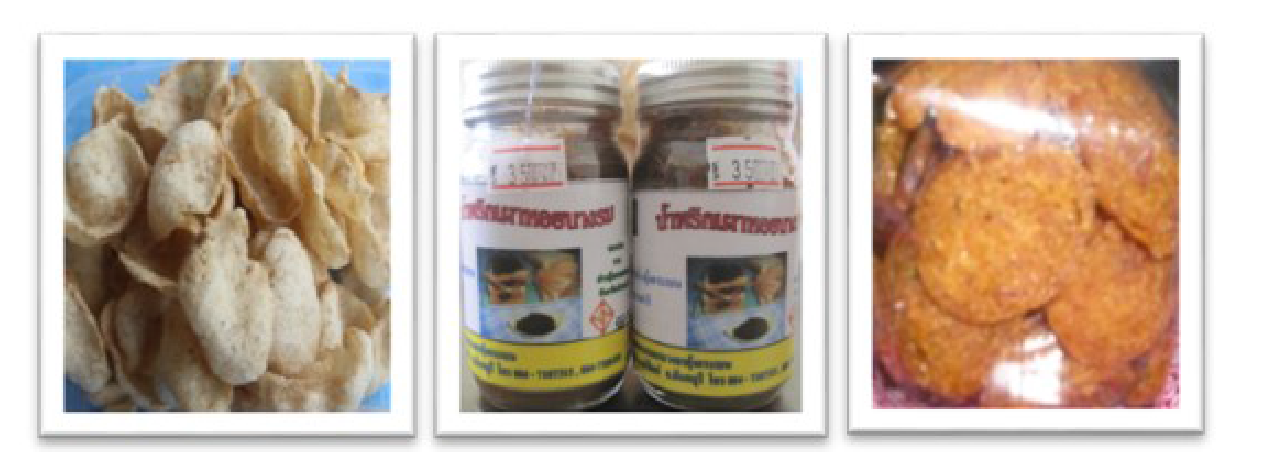Value added product development for oyster farmers’ group in Kung Krabaen Bay Royal Development Study Center, Chanthaburi
Main Article Content
Abstract
This research aimed to survey consumer preference for oyster product development, developed new recipes as well as promoted oyster farmers’ group in Kung Krabaen Bay Royal Development Study Center. The study asked 500 general consumers around Kung Krabaen Bay and tourists who had visited the area for feedback about oyster product. The majority of respondents preferred to Khaokriab, Numprikphao, and Todmonkrob products in 24.10, 23.40 and 18.57 frequency percentage, respectively. Three most prominent product ideas were developed in different product recipes, and tasted by 150 consumers in the study area. Each product recipe revealed that most respondents preferred Khaokriab, Numprikphao, and Todmonkrob with 10% oyster in each formula at 7.41, 6.90 and 7.43 average hedonic scale point (1-9), respectively. These confirmed a formula of each product recipe by 100 consumers in the study area. The acceptance hedonic scale point of three products: Khaokriab, Numprikphao, and Todmonkrob were 7.34, 6.70 and 6.31 average hedonic scale point (1-9), respectively. The three product prototypes were promoted to oyster farmers’ group through a training process by the researcher. The training was continued until the group could reprocess products with the same quality as those made for trial. The group was preferred overall this development process at 4.61 (out of 5) average score point. Finally, the researcher assisted the farmer to apply FDA serial number for Khaokriab product until they had received the serial number.
Article Details
References
Calories in pacific Oyster, Available from: http://www.Recipeofhealth.com, (accessed 28 October 2018).
L. G. Eldredge, C. M. Smith, A guidebook of introduced marinespecies in Hawaii, Bishop museum technical report 21 August2001, University of Hawaii-Manoa, 2001.
Jud, Layman, Loxahatchee river oyster reef restoration moni-toring report: Using baselines derived, From long term moni-toring of benthic community structure on natural oyster reefs toassess the outcome of Large-scale oyster reef restoration. Prepared for Martin Country, state of Florida, 2011.
S. Klinbunga, P. Ampayup, A. Tassanakajon, P. Jarayabhand,W. Yoosukh, Development of species-specific markers of thetropical oyster (Crassostrea belcheri) in Thailand, MarineBiotechnology 2(5) (2000) 476–484.
K. Mark, The big oyster: History on the half shell, New York,Ballantine Books, 2006.
Nutrition Facts and Analysis for Mollusks, oyster, wild, raw,Available from: http://www.Nutritionaldata.com, (accessed 28October 2018).
D. K. Padilla, Context-dependent impact of a non-native ecosystem engineer, The pacific oyster,Crassostrea gigas, In-tegrative and Comparative Biology 50(2) (2010) 213 – 225.
Pearly wisdom: oysters are an aphrodisiac, Available from: TheSydney Morning Herald, (accessed 28 October 2018).
R. W. Veryzer Jr., Discontinuous innovation and the new Prod-uct development process, Journal of Product Innovation Pro-cess 15(4) (2003) 304 – 321.
S. Robecca, Oyster, The University of Chicago Press.
Y. M. Choi, S. H. Sprigle, Approaches for evaluating the us-ability of assistive technology product prototypes, AssistiveTechnology 23 (2011) 36 – 41.


